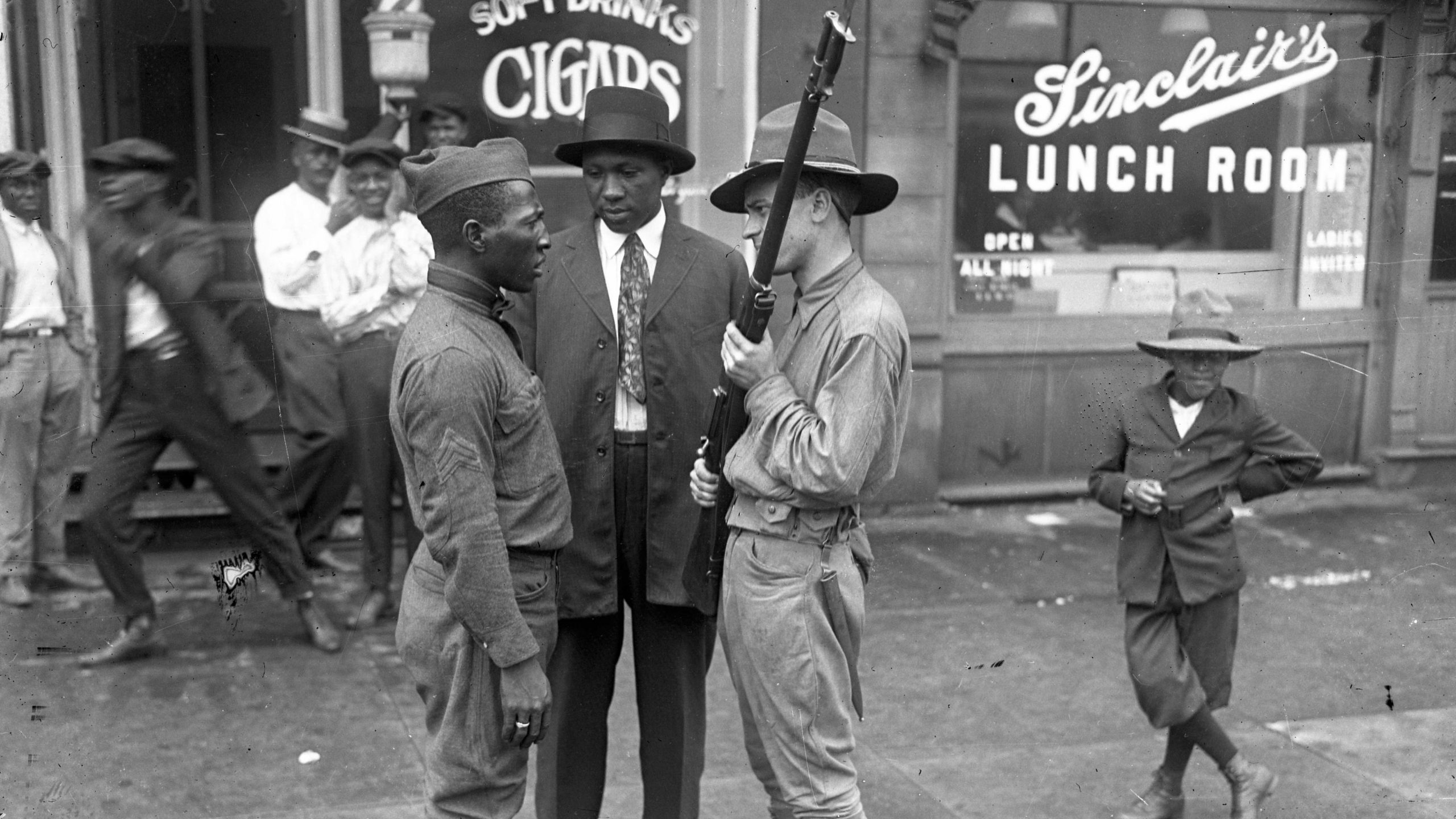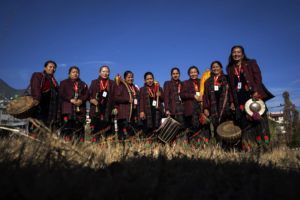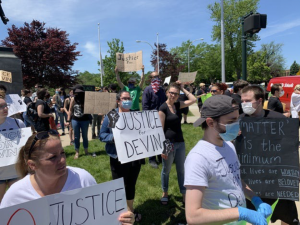“The problem is the way policing was built,” historian Khalil Muhammad says.
Eugene Williams, a 17-year-old black boy, was stoned to death by white people in 1919 after he swam into what they deemed the wrong part of Lake Michigan.
In response, black people in Chicago rose up in protest, and white people attacked them. More than 500 people were injured and 38 were killed. Afterward, the city convened a commission to study the causes of the violence.
The commission found “systemic participation in mob violence by the police,” Khalil Muhammad, a professor of history, race, and public policy at Harvard Kennedy School and author of the book The Condemnation of Blackness: Race, Crime, and the Making of Modern Urban America, told Vox. “When police officers had the choice to protect black people from white mob violence, they chose to either aid and abet white mobs or to disarm black people or to arrest them.”
In the process of compiling the report, white experts also testified that “the police are systematically engaging in racial bias when they’re targeting black suspects,” Muhammad said. The report “should have been the death of systemic police racism and discrimination in America.”
That was in 1922.
It’s almost 100 years later, and thousands of Americans are in the streets daily, protesting the same violence and racism that the Chicago commission documented. It may seem like nothing can change, but Muhammad said the last several weeks could be a wake-up call for some Americans to what policing in this country really means.
Part of that awakening, though, also involves understanding the history of police violence.Muhammad’s work focuses on systemic racism and criminal justice; The Condemnation of Blackness deals with the idea of black criminality, which he defines as the process by which “people are assigned the label of criminal, whether they are guilty or not.” That process has been a vicious cycle in American history, Muhammad explains, wherein black people were arrested to prevent them from exercising their rights, then deemed dangerous because of their high arrest rates, which deprived them of their rights even further.
I spoke with Muhammad by phone to better understand this history, what it means today, and what it would take to make 2020 and beyond different from 1922. A transcript of our conversation, lightly edited for length and clarity, follows.
Anna North
Can you trace how the idea of black criminality appeared in America, starting with slavery?
Khalil Muhammad
The notion of criminality in the broadest sense has to do with slave rebellions and uprisings, the effort of black people to challenge their oppression in the context of slavery. Slave patrols were established to maintain, through violence and the threat of violence, the submission of enslaved people. But we really don’t get notions of black criminality in the way that we think of them today until after slavery in 1865.
The deliberate choice to abolish slavery, [except as] punishment for crime, leaves a gigantic loophole that the South attempts to leverage in the earliest days of freedom. What that amounts to is that all expressions of black freedom, political rights, economic rights, and social rights were then subject to criminal sanction. Whites could accuse black people who wanted to vote of being criminals. People who wanted to negotiate fair labor contracts could be defined as criminals. And the only thing that wasn’t criminalized was the submission to a white landowner to work on their land.
Shortly afterwards, a lot of the South builds up a pretty robust carceral machinery and begins to sell black labor to private contractors to help pay for all of this. And for the next 70 years, the system is pretty much a criminal justice system that runs alongside a political economy that is thoroughly racist and white supremacist. And so we don’t get the era of mass incarceration in the South, what we get is the era of mass criminalization. Because the point is not to put people in prison, the point is to keep them working in a subordinate way, so that they can be exploited.
Anna North
What was happening in the North while this mass criminalization was happening in the South?
Khalil Muhammad
There had already been African Americans [in the North] before the end of slavery, and they were subjected to forms of segregation. But it wasn’t really until the beginning of the 20th century, when streams of black migrants began to move to northern cities, and particularly during World War I and what became known as the Great Migration, that we began to see the increased ascription of black people as prone to criminality, as a dangerous race, as a way of essentially limiting their access to the full fruits of their freedom in the North.
Social science played a huge role. What we’d call today “academic experts,” of one kind or another, were part of the effort to define black people as a particular criminal class in the American population. And what they essentially did was they used the evidence coming out of the South, beginning in the first decades after slavery. They used the census data to point to the disproportionate incarceration of African Americans. They were almost three times overrepresented in the 1890 census in Southern prisons.
So that evidence became part of a national discussion that essentially said, “Well, now that black people have their freedom, what are they doing with it? They’re committing crimes. In the South and in the North, and the census data is the proof.”
And so people began to build on that data and add to it. Police statistics began to become more important in determining how black people were doing, whether they were behaving or not. We quickly moved from census data to local data, from South to North, and we begin to see the consolidation of a set of facts that black people have a crime problem.
Anna North
So it’s a cycle: Black people were incarcerated in the South, and because they were incarcerated, this whole theory that black people were criminal was built on top of that?
Khalil Muhammad
That’s exactly what I’m saying. Of course, there’s no footnotes or asterisks to what was happening in the South. People just take the data at face value, kind of like people take the data at face value today. They just look at the data and say, “Oh, well of course, look what’s happening in these communities.”
Anna North
How do we see these attitudes about black criminality play out in policing around the country, leading up through the 20th century to the present?“WHEN POLICE OFFICERS HAD THE CHOICE TO PROTECT BLACK PEOPLE FROM WHITE MOB VIOLENCE, THEY CHOSE TO EITHER AID AND ABET WHITE MOBS OR TO DISARM BLACK PEOPLE OR TO ARREST THEM”
Khalil Muhammad
Once we have the consolidation of the fact that crime statistics prove nationally, everywhere, that black people have a crime problem, the arguments for diminishing their equal citizenship rights are national. They’re not just Southern any longer. And they’re at every level of society — local, state, federal.
They are existing in cultural products like The Birth of a Nation, the first truly major Hollywood film release. Black criminality becomes the most dominant basis for justifying segregation, whether legal or by custom, everywhere in America.
It had already defined the heart of the Jim Crow form of segregation, but it really begins in the Great Migration period to shape the maldistribution of public goods for black people — access to neighborhoods, access to schools, access to hospitals, access to forms of leisure. And, of course, all of these restrictions are enforced by white citizens but most especially by local law enforcement, by police officers.
In the South, police were less on the front lines because there were fewer of them. There was more vigilante enforcement of white supremacy: A white man really could shoot a black man or woman down in the middle of the street and get away with it. That was less likely to happen in the North — what was more likely to happen was for a white resident to simply call the police.
The same basic idea that in white spaces, black people are presumptively suspect, is still playing out in America today. The idea that police officers should prevent crime in black communities, rather than simply policing the borders of black communities, is what gave us stop and frisk, which actually is not just from the 1990s or inspired by “broken windows” policing, but versions of it were playing out very officially in the 1960s. And by looking at the archives, which I’ve done in my book, unofficially and unnamed, going back to the 1910s and ’20s.
So this idea that you can prevent crime in a community where the crime statistics say a lot of crime happens, and presume that a certain demographic of black men — especially in that community — are likely criminals, that logic begins as early as the 1960s. And it’s still playing out.
While that pattern played out, one of the things that happens during Prohibition is that the manufacturing and distribution of alcohol creates this massive underground economy, which is now being regulated by white ethnic men who don’t sue each other in civil court, but actually shoot at each other when they’re competing over the spoils of bootlegging. And a lot of that action is deliberately put in black communities.
The speakeasies, the corruption is hidden within black communities. Everyone is complicit in this: The bootleggers are complicit, the police are complicit. The only people who aren’t complicit are everyday working-class black people who don’t want what’s happening in their communities to be happening.
The effect of that is to produce yet another battery of crime statistics coming out of Northern cities that shows high rates of arrest of black people during the Prohibition period, when in fact, they’re being targeted for political clampdowns of overwhelmingly white underground activity. It’s just remarkable.
And yet again, the white public doesn’t read any footnotes or get any asterisks to it. What they get is evidence of disproportionate numbers of arrests in the black community during a time where just about everybody knew who was behind bootlegging.
[But] black people — black reformers, black activists, black scholars, black journalists — were always documenting what was happening to them. They were always resisting and they made some headway, beginning in the 1920s, around calling attention to systemic police racism and discrimination.
Anna North
That’s the next thing I wanted to ask about. I know that you wrote about this a little bit in your Washington Post op-ed last year — talk to me a little bit about the history of protests against racist policing.
Khalil Muhammad
The earliest days of the civil rights movement were focused on the problem of lynching. The NAACP literally begins because of lynching. And [one] reason was because of the threat of lynching in the North. It’s not to say that the progressives who founded the organization in 1910 didn’t care about lynching that had been going on in the South. But it was kind of like a George Floyd moment. It was like, “Holy smokes, if this can happen in Springfield, Illinois, where a lynching had occurred in 1909, then we’ve got to draw a line in the sand.”
Alongside their focus on racial violence in the earliest days, they also began to pay attention to police violence, particularly in the North, because the NAACP leadership was in Northern cities. It was headquartered in New York. And so what was happening in their own backyards was more like systemic police violence than lynch mobs. And that began the process, particularly for W.E.B. Du Bois, who establishes kind of a police blotter, or let’s call it a police-brutality blotter, and the primary magazine for the organization.
Ida B. Wells, who was also another founder of the NAACP, begins to organize around police violence and other forms of racial violence in those cities. African Americans themselves start to resist policing and call attention. Ministers, teachers, bricklayers — essentially what was the working and professional class of black America at the turn of the 20th century — are very vocal, and they demand police reform. They demand accountability for criminal activity amongst the police and they don’t get any of it.
By the 1920s, the first of a series of race riots erupts in East St. Louis, spreads to Philadelphia. Another one occurs in Chicago. The Chicago one is sparked by the death of a [17-year-old] swimming in Lake Michigan who crosses an aqueous color line. Black people are outraged. They want justice. White people take offense and begin to attack them in their communities.“THE SAME BASIC IDEA THAT IN WHITE SPACES, BLACK PEOPLE ARE PRESUMPTIVELY SUSPECT, IS STILL PLAYING OUT IN AMERICA TODAY”
And what comes out of that is the first blue-ribbon commission to study the causes of riots. In that report, the Chicago commission [concludes] that there was systemic participation in mob violence by the police, and that when police officers had the choice to protect black people from white mob violence, they chose to either aid and abet white mobs or to disarm black people or to arrest them. And a number of people testify, all of whom are white criminal justice officials, that the police are systematically engaging in racial bias when they’re targeting black suspects, and more likely to arrest them and to book them on charges that they wouldn’t do for a white man.
This report in 1922 should have been the death of systemic police racism and discrimination in America. It wasn’t. Its recommendations were largely ignored.
And a decade later, Harlem breaks out into what is considered the first police riot, where African Americans believe that an Afro-Puerto Rican youth has been killed by the police. Turns out he hadn’t been, but the rumor that he had leads to a series of attacks directed towards white businesses in Harlem and against the police. And eventually, that uprising leads to the Harlem riot report in 1935.
That report comes to the same conclusion, notes there needs to be accountability for police that need to be charged and booked as criminals when they engage in criminal activity. They call for citizen review boards and an end to stop and frisk, which they name in the report. And Mayor [Fiorello] La Guardia, the mayor of New York, shelves it, doesn’t do anything with it, doesn’t even share [it] with the public. The only reason it ever saw the light of day was because the black newspaper, the Amsterdam News, published it in serial form.
And a similar report is produced in 1943, and another report in 1968. They essentially all keep repeating the same problem.
Anna North
Given the history of clear identification of this problem, is now any different? Are we seeing any shift in attitudes of white Americans toward the idea of black criminality? Will we see any changes come out of this moment?
Khalil Muhammad
If we count the last two weeks as evidence of some outward show of consciousness and commitment to something different, I would say this: This moment is very helpful when it comes to taking on this question. The problem is that none of us can know how long this will last. None of us can know whether the simple charging of three other men and eventual conviction for all involved in the killing of George Floyd will be the answer people were looking for who are newcomers to this.
But I can tell you that a lot of the activists and movement leaders, the organizers, academics like myself, know that this has never been a problem about one, two, three, or four officers who unjustly kill an unarmed, innocent black person — and I say innocent because George Floyd had not been convicted of anything. We know that this has never been about that.
The problem is the way policing was built and what it’s empowered to do, which is — to put it in terms that are resonant in this moment — they’ve been policing the essential workers of America. And the fact that black people over-index as the essential workers of America, when in fact, that was what their presence here was meant to be about: to provide the labor to build wealth in America, and then the only form of freedom that they really ever had, which was the freedom to work for mostly white people.
In this pandemic moment, I think we’re able to see more clearly that the very people we’re willing to sacrifice the civil rights and civil liberties of are the very people we also depend upon to keep our utilities running and our groceries coming into our homes.
What this moment leads us to is a crossroads for most newcomers to define justice beyond an individual case or even cases, but to define justice as a form of limiting what police officers have been able to do, which is to protect white privileges in America. Some people call that defunding the police. Some people call it abolition. But what it all means is that there should be less policing of black America and more investment in the [socioeconomic] infrastructure of black communities. And police officers are not the people to do that work.




